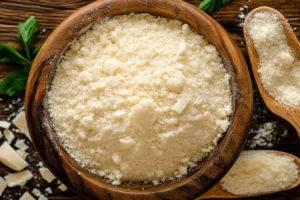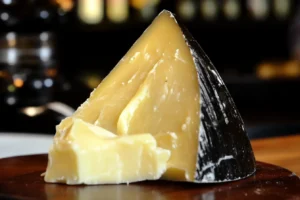Initiation to Parmesan Cheese
Parmesan cheese is a popular ingredient known for its rich, nutty flavor. It is a hard cheese originally from Italy. It often adds a delicious taste to pasta, soups, and salads. Authentic Parmesan is called Parmigiano-Reggiano, but many store-bought options are labeled Parmesan.
Whether you use grated or shredded Parmesan can make a big difference in your cooking. Both forms of Parmesan are helpful, but they have specific roles. Therefore, knowing when and how to use them helps answer the question: can you use grated Parmesan instead of shredded Parmesan?
Key Differences Between Grated and Shredded Parmesan
The main difference between grated and shredded Parmesan lies in their texture:
- Grated Parmesan: Very fine, like a powder. It spreads evenly and melts quickly.
- Shredded Parmesan: Thin strips or pieces melt more slowly and add texture.
As a result, grated Parmesan is great for sauces or soups, while shredded Parmesan works well for salads and baked dishes. To decide if you can use grated Parmesan instead of shredded Parmesan, it’s important to consider how texture affects the dish.
These differences affect cooking outcomes. For instance, when preparing dishes like Alfredo, the choice of Parmesan impacts the smoothness and creaminess of the sauce. Learn more about grated Parmesan vs shredded Parmesan for Alfredo.
Why Texture Matters in Cooking
The texture of Parmesan cheese changes how it behaves in a recipe:
- Melting: Grated Parmesan melts faster, making it perfect for smooth sauces.
- Feel in the Mouth: Shredded Parmesan gives a chewy bite, adding to the dish’s texture.
For this reason, grated Parmesan mixes easily, while shredded Parmesan stands out more in dishes. So, when you think you use grated Parmesan instead of shredded Parmesan, remember that texture matters for both look and taste.
When Grated Parmesan Can Replace Shredded Parmesan

Grated Parmesan can be a good substitute for shredded Parmesan in some cases:
- In Sauces: It melts smoothly and creates a creamy texture.
- As a Topping: It works well on soups or pasta where you want an even sprinkle of cheese.
- In Baking: It blends easily into doughs or batters without changing the texture.
If texture isn’t very important in your recipe, grated Parmesan can work. However, you should always consider the role of cheese before asking if you can use grated Parmesan instead of shredded Parmesan.
However, for dishes emphasizing texture, shredded Parmesan remains essential. For example, in layered casseroles or gratins, shredded Parmesan forms a desirable golden crust. Similarly, the texture of shredded Parmesan adds visual appeal and a satisfying bite to salads and pizzas. For detailed insights into the culinary differences, examine the difference between Chicken Parmesan and Chicken Parmigiana.
When Not to Replace Shredded Parmesan with Grated Parmesan
There are certain times when shredded Parmesan is the better choice, and grated Parmesan won’t work as well:
- On Salads: Shredded Parmesan adds a fancy look and a nice chewy texture.
- On Pizza: Shredded Parmesan melts slowly and forms a delicious cheesy layer.
- In Gratins: Shredded Parmesan creates a crispy, golden crust.
Grated Parmesan doesn’t give the same look or feel in these cases. So, the answer to whether you can use grated Parmesan in place of shredded Parmesan is often no for these dishes.
How to Turn Shredded Parmesan into Grated Parmesan (and Vice Versa)
You can easily change Parmesan from one form to another if needed:
- To Grated: Use a fine grater or a food processor to turn shredded Parmesan into powder.
- To Shredded: Use a larger grater or a vegetable peeler to create strips from a block of Parmesan.
These methods are quick and easy, but they might not perfectly match the texture of store-bought versions. Still, these tricks can be beneficial when you’re stuck and wondering if you can use grated Parmesan instead of shredded Parmesan.
Best Ways to Store Parmesan Cheese
Storing Parmesan correctly keeps it fresh and flavorful for longer:
- Refrigerate: Wrap it in wax paper and then plastic wrap to prevent drying.
- Freeze: Grated Parmesan freezes well, but shredded Parmesan may lose some texture.
- Use Airtight Containers: This protects the cheese from the air and keeps it fresher.
Proper storage also depends on whether you’re storing grated or shredded Parmesan. This can help you decide if you can use grated Parmesan instead of shredded Parmesan.
Parmesan Cheese in Different Cuisines
Parmesan cheese is used in many cuisines around the world:
- Italian Dishes: A key ingredient in pasta, risotto, and pizza.
- French Recipes: Adds flavor to quiches and soufflés.
- American Meals: Found in Caesar salads and cheesy casseroles.
No matter the cuisine, Parmesan’s flavor fits well in traditional and modern dishes. Whether you can use grated Parmesan instead of shredded Parmesan often depends on the specific recipe and how the cheese is used.
Parmesan cheese is a versatile ingredient that adds flavor to many dishes. Grated Parmesan can sometimes replace shredded Parmesan, but it’s important to know when the texture will make a difference. So, when you ask if you can use grated Parmesan instead of shredded Parmesan, think about how the cheese will look and taste in your dish. With these tips, you’ll always get the best results in your cooking.
Health and Nutritional Profile of Parmesan Cheese
Parmesan cheese is not just delicious but also packed with nutrients. Rich in protein, it helps build and repair muscles. For instance, just one ounce of Parmesan gives you about 10 grams of protein, making it a great addition to your meals.
Additionally, this cheese is high in calcium, which is essential for strong bones and teeth. In fact, one serving can provide nearly 30% of your daily calcium needs. Moreover, it contains important minerals like phosphorus and magnesium that support your body’s functions.
If you’re watching your calorie intake, Parmesan is a good choice in moderation. Its bold flavor means you can use less and still enjoy its taste. As a result, it’s a smart option for flavor-packed meals.
Key nutrients in Parmesan include:
- Protein for muscle health
- Calcium for strong bones
- Vitamin A for healthy eyesight
- Riboflavin for energy
Tips for Improving Flavor with Parmesan Cheese
Parmesan cheese can add amazing flavor to your cooking. Here are some simple tips to make the most of this nutty and savory cheese.
First, grate it fresh. Freshly grated Parmesan tastes much better than store-bought options. Always use a fine grater for the best results.
Second, pair it wisely. Parmesan works well with ingredients like garlic, basil, and tomatoes. Together, these flavors increase the cheese’s natural taste.
Next, use it as a topping. For example, sprinkle it over soups, pasta, or salads for extra flavor and texture.
Additionally, melt it into dishes. Add Parmesan to sauces or roasted vegetables for a creamy, cheesy finish.
Lastly, know when to use grated or shredded Parmesan. Can you use grated Parmesan in place of shredded Parmesan? Yes, grated Parmesan blends better in sauces, while shredded adds texture.
Using these tips, you can enjoy the full flavor of Parmesan in every dish.
Parmesan Alternatives: When You Run Out
If you don’t have Parmesan cheese, don’t worry! Fortunately, many substitutes can deliver similar flavors. Here are some great options.

To begin, Pecorino Romano is a good alternative. It’s a bit saltier than Parmesan but a strong and flavorful replacement.
Additionally, Asiago cheese works well. It is milder and nuttier, making it a great option in recipes with unavailable Parmesan.
Another choice is Grana Padano, which is similar in taste and texture to Parmesan. Therefore, it’s a great option for grating or shredding.
Finally, nutritional yeast is a non-dairy option with a cheesy flavor, perfect for vegans.
Can you use grated Parmesan in place of shredded Parmesan when substituting? Yes, but it may slightly change the texture of your dish. These alternatives help keep your recipes on track, even without Parmesan.
How Parmesan Impacts Texture and Flavor Profiles
Parmesan cheese changes the texture and flavor of dishes in special ways. Specifically, its dry, crumbly texture makes it perfect for grating or shredding.
Regarding texture, Parmesan adds a crunchy topping to salads or soups. At the same time, when grated, it melts smoothly into sauces, creating a creamy texture.
As for flavor, its nutty, salty taste increases the umami, or savory, flavor in dishes. Parmesan’s aging process gives it a deep, rich flavor, making it a versatile ingredient.
Can you use grated Parmesan in place of shredded Parmesan when considering texture? Yes, but the choice depends on your dish. For instance, grated Parmesan mixes smoothly into sauces, while shredded adds a chunkier texture. Both forms can make your recipes taste delicious in different ways.
These considerations are vital when crafting visually impressive or texturally complex dishes like mac and cheese. Discover the irresistible secrets to perfect mac and cheese every time.
Where to Buy High-Quality Parmesan Cheese
To get the best results, you should choose authentic Parmesan cheese. Look for products labeled Parmigiano-Reggiano, which meet strict Italian standards.
Where to find it:
- Specialty stores: Cheese shops often carry imported Parmesan. Therefore, they are a reliable option.
- Farmer’s markets: Local sellers might have fresh, high-quality Parmesan, so check your nearby market.
- Online stores: Many websites sell real Parmigiano-Reggiano, making it convenient to buy from home.
- Supermarkets: Larger grocery stores usually have an imported cheese section, which often includes Parmesan.
For authenticity, check the cheese rind for the official Parmigiano-Reggiano stamp. This insures you’re buying the real thing. Can you use grated Parmesan in place of shredded Parmesan when shopping? Pre-grated cheese is handy. However, buying a whole block and grating it fresh gives you the best flavor.
Conclusion: Choosing the Right Parmesan for Your Dish
Picking the right Parmesan cheese can make your meals even better. Therefore, always choose authentic Parmigiano-Reggiano for its great taste and quality.
For example, use grated Parmesan for smooth sauces. Meanwhile, shredded Parmesan works well for texture and toppings.
If you need a substitute, try Pecorino Romano or Asiago. However, be aware that they’ll taste slightly different.
Can you use grated Parmesan in place of shredded Parmesan? Yes, but each type works best in certain dishes. In conclusion, your meals will be flavorful, satisfying, and unforgettable with the right Parmesan.

